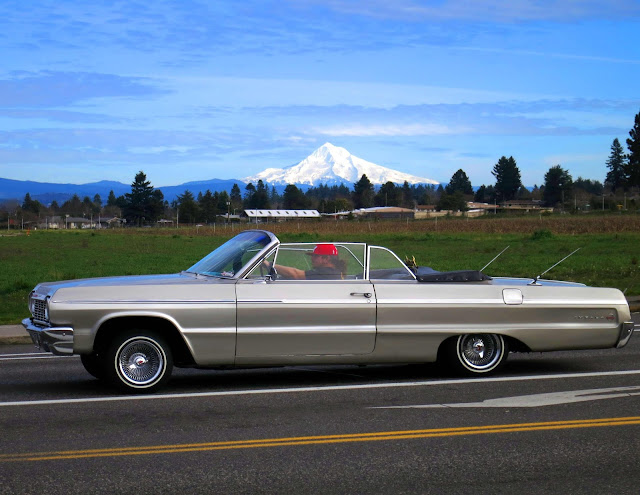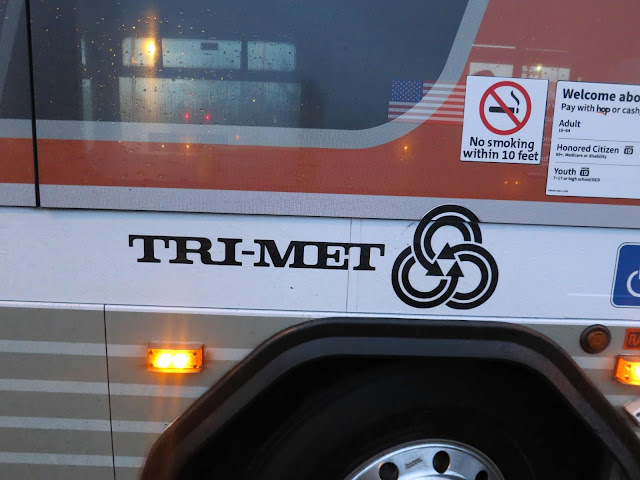3610
Herewith, a little trivial crumb that you can use to win bets and amuse people at parties, if they were the parties that existed and the sorts that I would attend. They involve Portland street names, because that's the way I roll.
1. NE Portland Highway. There is a road near the margins of North and Northeast Portland called Lombard Street. This totally like the Lombard in San Francisco, except ours is very long and doesn't go up hills and is in fact made of long, straight segments. Except for that, it's just like SF's Lombard Street. In as much as it's a street. It's also badged in the US Hwy System as US 30 Bypass and is one of the principal arterials across the north side of the Rose City.
First, a necessary digression: ODOT, as I may have said elsewhere but maybe is worth repeating now, has a way of numbering state highways that does not coincide with the posted highway numbers. Also, in the vulgate parlance, when someone says 'Highway' or 'State Hwy', what we mean is the route number, that is the one you'll see on the signs. What locals call Highway 213, which runs from the east side of Portland through Oregon City, the farmlands of Clackamas, past Molalla, through Silverton and into Salem is known, from Portland through about Silverton as State Hwy No.68 - Cascade Hwy North, and from there through Salem as State Hwy No. 160 - Cascade Hwy South.
Think of it like a catalog number. You'll order a Deluxe Whizzit with extra froom-froom rom Whizzit World but they also know it as Catalog No 67-325. But you wouldn't call it by Catalog number.
So! Since the posted route number is technically a State Route, and in this case an Oregon Route, when, in times future, I talk of a state highway by its route number, the nomenclature will be, in this case, for Oregon Route 213, OR 213. We don't say State Route or SR here, that's Washington, folks. Get it straight. We used to escort people back to the border for that.
Anyhow, and to get us back on course, the reason I told you that is because, even though Lombard Street isn't a Oregon highway route, it's maintained by the state and is classified as an Oregon highway, No. 123, as it would occur. And those viewing maps or travelling down this road east of NE 42nd Avenue but west of where it merges with NE Killingsworth will notice it goes by a particularly generic name: NE Portland Hwy.
While I don't have any way to run down why those who decided decided to change it where it is, I can tell you that the state's name for this highway is the Northeast Portland Highway. As State Hwy No. 123, it runs from Saint Johns, starting just across the river at Hwy 30 via the St Johns Bridge, all along Lombard Street and along Killingsworth and Sandy out to Troutdale.
But for that part between 42nd and approximately 72nd, where the city apparently decided adopting ODOT's name for the road was enough, and convenient too; it already contained the directional.
2. N Portland Road. Going north out of the Saint John's neighborhood, there is a road that runs along the railroad embankment from approximately where N Columbia Blvd goes over N Columbia Way to the south shore of the Columbia River at N Marine Drive. It's called North Portland Road. As Eugene E Snyder tells us, that was so named because there is a station along the railroad (the railroad equivalent of a wide spot in the road, trains never actually stopped there) which was itself called North Portland. When the street namers went out that way it must have seemed natural to call it North Portland Road, as it went out to that place, but when the Great Renaming came round in the 1930s, as the road itself would fall in the North quadrant, calling it North North Portland Road must have seemed a bit goofy. Once again, the historic name handily provided the necessary directional.
It too is a state highway: Hwy No. 120, Swift Highway ... not because it was a direct route into the area from the nearby stockyards, but because that used to be Portland's meat packing district, and Swift was the largest company. We also have a N Swift Street in the St Johns area dedicated to that memory.
State Hwy 120 is also one of the many unsigned state highways that adopted those numbers as state routes back in 2002. The majority of these are still unsigned; one not otherwise informed would never know a priori that N Portland Rd was also OR 120. Presumably ODOT's priorities lay elsewhere and, the way things are going in government these days, I wouldn't be the least surprised.
1. NE Portland Highway. There is a road near the margins of North and Northeast Portland called Lombard Street. This totally like the Lombard in San Francisco, except ours is very long and doesn't go up hills and is in fact made of long, straight segments. Except for that, it's just like SF's Lombard Street. In as much as it's a street. It's also badged in the US Hwy System as US 30 Bypass and is one of the principal arterials across the north side of the Rose City.
First, a necessary digression: ODOT, as I may have said elsewhere but maybe is worth repeating now, has a way of numbering state highways that does not coincide with the posted highway numbers. Also, in the vulgate parlance, when someone says 'Highway' or 'State Hwy', what we mean is the route number, that is the one you'll see on the signs. What locals call Highway 213, which runs from the east side of Portland through Oregon City, the farmlands of Clackamas, past Molalla, through Silverton and into Salem is known, from Portland through about Silverton as State Hwy No.68 - Cascade Hwy North, and from there through Salem as State Hwy No. 160 - Cascade Hwy South.
Think of it like a catalog number. You'll order a Deluxe Whizzit with extra froom-froom rom Whizzit World but they also know it as Catalog No 67-325. But you wouldn't call it by Catalog number.
So! Since the posted route number is technically a State Route, and in this case an Oregon Route, when, in times future, I talk of a state highway by its route number, the nomenclature will be, in this case, for Oregon Route 213, OR 213. We don't say State Route or SR here, that's Washington, folks. Get it straight. We used to escort people back to the border for that.
Anyhow, and to get us back on course, the reason I told you that is because, even though Lombard Street isn't a Oregon highway route, it's maintained by the state and is classified as an Oregon highway, No. 123, as it would occur. And those viewing maps or travelling down this road east of NE 42nd Avenue but west of where it merges with NE Killingsworth will notice it goes by a particularly generic name: NE Portland Hwy.
While I don't have any way to run down why those who decided decided to change it where it is, I can tell you that the state's name for this highway is the Northeast Portland Highway. As State Hwy No. 123, it runs from Saint Johns, starting just across the river at Hwy 30 via the St Johns Bridge, all along Lombard Street and along Killingsworth and Sandy out to Troutdale.
But for that part between 42nd and approximately 72nd, where the city apparently decided adopting ODOT's name for the road was enough, and convenient too; it already contained the directional.
2. N Portland Road. Going north out of the Saint John's neighborhood, there is a road that runs along the railroad embankment from approximately where N Columbia Blvd goes over N Columbia Way to the south shore of the Columbia River at N Marine Drive. It's called North Portland Road. As Eugene E Snyder tells us, that was so named because there is a station along the railroad (the railroad equivalent of a wide spot in the road, trains never actually stopped there) which was itself called North Portland. When the street namers went out that way it must have seemed natural to call it North Portland Road, as it went out to that place, but when the Great Renaming came round in the 1930s, as the road itself would fall in the North quadrant, calling it North North Portland Road must have seemed a bit goofy. Once again, the historic name handily provided the necessary directional.
It too is a state highway: Hwy No. 120, Swift Highway ... not because it was a direct route into the area from the nearby stockyards, but because that used to be Portland's meat packing district, and Swift was the largest company. We also have a N Swift Street in the St Johns area dedicated to that memory.
State Hwy 120 is also one of the many unsigned state highways that adopted those numbers as state routes back in 2002. The majority of these are still unsigned; one not otherwise informed would never know a priori that N Portland Rd was also OR 120. Presumably ODOT's priorities lay elsewhere and, the way things are going in government these days, I wouldn't be the least surprised.

















